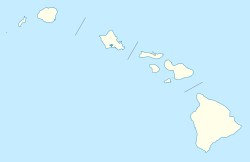Bobcat Trail Habitation Cave facts for kids
Quick facts for kids |
|
|
Bobcat Trail Habitation Cave (50-10-30-5004)
|
|
| Location | Central Hawaiʻi Island |
|---|---|
| Area | 0.3 acres (0.12 ha) |
| Built | 1449-1500 |
| Architectural style | Ancient Hawaiian |
| NRHP reference No. | 86001086 |
| Added to NRHP | May 15, 1986 |
The Bobcat Trail Habitation Cave is a special historical place on the island of Hawaiʻi. It was once a home for Ancient Hawaiian people. This cave is found in a quiet, faraway part of the island. It helps us learn how people lived long ago in Hawaiʻi.
Where is the Bobcat Trail Cave?
The Bobcat Trail Habitation Cave is located in the central part of Hawaiʻi Island. It's in an area called Puuanahulu ahupuaʻa. An ahupuaʻa was like a land division in ancient Hawaiʻi. It stretched from the mountains to the sea. This cave is part of the North Kona District.
To protect this important historical site, its exact spot is kept a secret. It's on land owned by the U.S. Federal government. This land is part of the Pohakuloa Training Area.
The cave is very high up, between 5,100 and 9,000 feet (about 1,550 to 2,740 meters) above sea level. This area is quite dry. It gets only about 20 inches (500 mm) of rain each year. The plants here are mostly dry shrubs. They are similar to what you might find in high mountain areas.
The cave gets its name from a nearby path called the Bobcat Trail. People have suggested that this trail could become part of a bigger trail system on Mauna Loa.
Who Lived in the Cave and Why?
The Bobcat Trail was part of a network of paths used by ancient Hawaiians. These paths were used even before the time of [[King ʻUmi-a-Liloa]]. King ʻUmi moved his royal home to a nearby spot in the 1500s. That place is now called Ahu A ʻUmi Heiau.
At first, studies focused on the coastal areas where people still live today. But even this higher, drier area shows signs of human activity. People lived here from about A.D. 700 until the 1700s. Ancient Hawaiians hunted birds and gathered wood on this high plateau.
They valued both seabirds and forest birds. Seabirds nested here and were a source of food. Forest birds had colorful feathers. These feathers were used to make special clothes for ceremonies.
When hunting, people camped in caves. These caves were formed by lava tubes. Lava tubes are like natural tunnels left behind by flowing lava. People would place gourds (hollowed-out plants) on the floor. This was to collect water that dripped from the cave ceiling.
The forests also provided sandalwood and plants used for medicine. Bundles of sandalwood were found in the caves. They were left there to be carried later to bigger communities on the coast.
Protecting This Special Place
The Bobcat Trail Habitation Cave is an important archaeological site. It has a state archaeological site number: 10-30-5004. This number, with "50-" for Hawaii, was added to its name on the National Register.
It was added to the National Register of Historic Places on May 15, 1986. This means it's recognized as a very important historical site in the United States.
In 1995, the U.S. Army paid for a big study of the area. This study helped create a plan to manage the environment. In 2004, another study was done. This was for some planned improvements to the training area.
While this cave is the only one officially listed, there are several other caves in the area. They also hold clues about ancient Hawaiian life.


